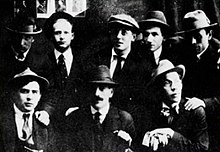
Di Yunge was the first major literary movement of Yiddish poetry in America. During the early 20th century, their work emphasized romanticism, individualism, subjectivism, and free and indirect expression.
History
Yiddish literature was most prominent in Eastern Europe during the century preceding World War I. In the period leading up to World War II, Yiddish literature in Poland and Russia changed in response to the political status of Jews. For a time in-between, countries across the Americas developed a literature of new immigrants, of which Di Yunge was the first important group of Yiddish poets in America.
The writers of the literary movement known as Di Yunge emigrated to the United States from Eastern Europe between 1902 and 1911 as part of a wider migration of Jews from that region. Di Yunge, which translates as "the young ones" or "youngsters", typified the Jewish immigrant: young, unwed, and impoverished. As a group, their influences included Heinrich Heine, German Expressionism, and Russian symbolism. Their work was characterized by its romanticism and advocacy for individualism, subjectivism, and free and indirect expression. Di Yunge was the first school of Yiddish literature to stress an aesthetic standard above a social and national purpose; it sought to eschew the communal and didactic perspectives of the socialist labor poetry of the previous generation (represented by poets such as David Edelstadt and Morris Rosenfeld).
Di Yunge writers included I. J. Schwartz, Mani Leib, Zishe Landau, Itzik Manger, Aaron Zeitlin, Moyshe-Leyb Halpern and David Ignatoff. The group of poets differed in regional origin and politics. Schwartz's Kentucky was the first American Yiddish epic—it tells how the new rural life of Jewish immigrants changed their Jewish spiritual life. Schwartz later won the 1970 Itzik Manger Prize for poetry in Israel.
After World War I and the Russian Revolution of 1905, a less defiant group known as the Insichists (or "In-Zikh"), who sought to "refract the outer world through the prism of the self", replaced Di Yunge.
Notes
- ^ Ross-Daniel 1985, p. 41.
- Whitman 1966, p. 205.
- Wisse 1981, p. 43.
- ^ Whitman 1966, pp. 205–6.
- Wisse 1976, p. 266.
- Hellerstein 1987, p. 228.
- Liptzin & Norich 2007.
References
- Dubrovsky, Gertrude W. (1992). "Trees and Blood: a Yiddish Poet's View of America". CrossCurrents. 42 (1): 83–89. ISSN 0011-1953. JSTOR 24459278.
- Hellerstein, Kathryn (1987). "The Demon Within: Moyshe-Leyb Halpern's Subversive Ballads". Prooftexts. 7 (3): 225–248. ISSN 0272-9601. JSTOR 20689188.
- Liptzin, Sol; Norich, Anita (2007). "In-Zikh". In Berenbaum, Michael; Skolnik, Fred (eds.). Encyclopaedia Judaica. Vol. 10 (2nd ed.). Detroit: Macmillan Reference. p. 5. ISBN 978-0-02-866097-4.
- MOORE, DEBORAH DASH; LINDEN, DIANA L. (2012). "Jews and New York Culture". In POLLAND, ANNIE; SOYER, DANIEL (eds.). Emerging Metropolis. New York Jews in the Age of Immigration, 1840-1920. NYU Press. pp. 207–243. ISBN 978-0-8147-6770-2. JSTOR j.ctt9qfcb4.13.
- Ramras-Rauch, Gila (1990). "Review of A Little Love in Big Manhattan". World Literature Today. 64 (1): 139–140. doi:10.2307/40145958. ISSN 0196-3570. JSTOR 40145958.
- Ross-Daniel, Dalia (1985). "Memory and Reconstruction of Self in Contemporary Yiddish Literature". World Literature Today. 59 (1): 40–44. doi:10.2307/40140531. ISSN 0196-3570. JSTOR 40140531.
- Whitman, Ruth (1966). "Four Modern Yiddish Poets". The Antioch Review. 26 (2nd): 205–212. doi:10.2307/4610761. ISSN 0003-5769. JSTOR 4610761.
- Wisse, Ruth R. (1976). "Di Yunge and the Problem of Jewish Aestheticism". Jewish Social Studies. 38 (3/4): 265–276. ISSN 0021-6704. JSTOR 4466938.
- Wisse, Ruth R. (1981). "Di Yunge: Immigrants or Exiles?". Prooftexts. 1 (1): 43–61. ISSN 0272-9601. JSTOR 20688986.